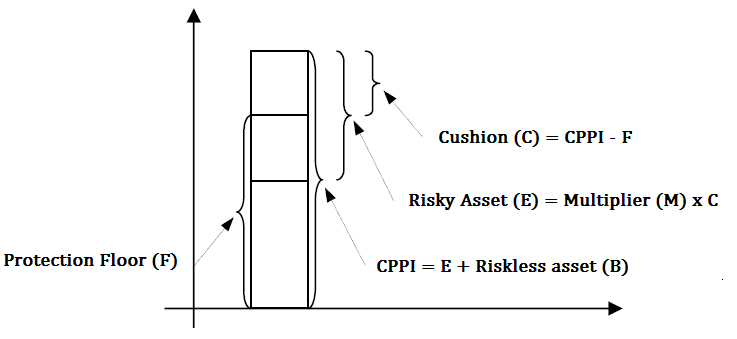Constant Proportion Portfolio Insurance (CPPI)¶
In [1]:
import numpy as np
import pandas as pd
import edhec_risk_kit as erk
import matplotlib.pyplot as plt
%matplotlib inline
Run a Constant Proportion Portfolio Insurance (CPPI) strategy: ¶
- Keep exposure in a risky asset for upside potential, while ensuring capital preservation by increasing allocation to a safe asset if your portfolio value is nearing a set floor.

In [2]:
ind_return = erk.get_ind_returns()
# simulate returns from a safer asset, like bonds,
# using geometric brownian motion
safe_r = erk.gbm(
n_years=10,
n_scenarios=1,
mu=0.03,
sigma=0.015
).pct_change().dropna()
# retrieve telecom returns from 2005 to 2014
# some processing so it runs properly in run_cppi()
risky_r = ind_return.loc['2005':'2014', 'Telcm'].reset_index().drop('index', axis=1)
risky_r.columns = [0]
# CPPI with monthly rebalances
# m = cushion multiplier
backtest = erk.run_cppi(
risky_r=risky_r,
safe_r=safe_r,
m=2,
start=1000,
floor=0.7,
)
Plot performance of CPPI strategy (black) vs strategy of allocating 100% of portfolio to the risky asset (orange)¶
- Set protection floor F to 70% of the initial investment
In [3]:
fig, ax = plt.subplots(figsize=(12,6))
backtest['Wealth'].plot(ax=ax, color='k', legend=False)
backtest['Risky Wealth'].plot(ax=ax, color='orange', style='--', legend=False)
ax.axhline(1000*0.8, color='red', linestyle='--')
plt.show()
Explore how adjusting CPPI parameters affects floor violations ¶
How does increasing the cusion multiplier m from 2 to 3 affect floor violations? Notice in the above example, there were no floor violations in the above case with m=2
In [4]:
# CPPI with monthly rebalances
# m = cushion multiplier
backtest = erk.run_cppi(
risky_r=risky_r,
safe_r=safe_r,
m=3,
start=1000,
floor=0.7,
)
In [5]:
fig, ax = plt.subplots(figsize=(12,6))
backtest['Wealth'].plot(ax=ax, color='k', legend=False)
backtest['Risky Wealth'].plot(ax=ax, color='orange', style='--', legend=False)
ax.axhline(1000*0.8, color='red', linestyle='--')
plt.show()
With m=3, we had a floor violation during the '08 recession. Check what the portfolio value dropped to.¶
Remember our floor value was set to 80% of the initial 1000 investment = 800
In [6]:
backtest['Wealth'].min()
Out[6]:
Utilize a max drawdown constraint to create a moving floor. Set the floor value to 70% of max(peak, account_value)¶
In [7]:
# with m=3, floor value being 70% of max(peak, account_value),
# max allocation to risky assket is 3*(100-70) = 90%
backtest = erk.run_cppi(
risky_r=risky_r,
safe_r=safe_r,
m=3,
start=1000,
riskfree_rate=0.02,
drawdown=0.3
)
In [8]:
fig, ax = plt.subplots(figsize=(12,6))
backtest['Wealth'].plot(ax=ax, color='k', legend=False)
backtest['Risky Wealth'].plot(ax=ax, color='orange', style='--', legend=False)
ax.axhline(1000*0.8, color='red', linestyle='--')
plt.show()
Summary of CPPI's returns¶
In [9]:
erk.summary_stats(backtest['Wealth'].pct_change().dropna())
Out[9]:
Summary of 100% Telecom returns¶
In [10]:
erk.summary_stats(backtest['Risky Wealth'].pct_change().dropna())
Out[10]:
CPPI strategy provided much better risk protection¶
- Max drawdown was halved,
- Negative skewness reduced,
- VaR and CVar near halved
- Higher Sharpe ratio
- Much less fat tail on distribution of monthly returns (kurtosis)
Although, overall, it underperformed because of the run from 2009-2015